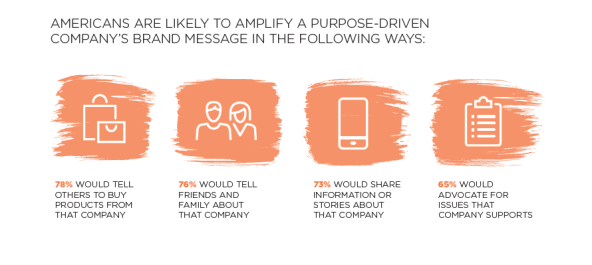Facebook goes on an advertising apology tour while Uber states it is “Moving Forward,” and Nike works to shed its internal boys club culture. These are just a few of the companies issuing mea culpas to consumers. Why? Because times have changed. Today, consumers and other stakeholders expect companies to do more than just offer products and services.
Our public relations and marketing firm, Cone, has tracked consumer behavior in relation to corporate responsibility for nearly three decades, and consumer expectations of companies remain on a steady upward track. It’s not enough for companies to participate in short-term or flash-in-the-pan support of causes or issues. Consumers are more sophisticated than they were 30 years ago and now expect companies to lead with purpose, by deeply embedding social and environmental impact into their very reason for being.


And companies are catching on. This article series demonstrates the multidimensional ways brands are bringing purpose to life. We’ve seen unique partnerships between social enterprises and large companies, such as the one between Misfit Juice and food giant Baldor foods; the results of CVS Health’s bold move to stop selling tobacco; and how participating in volunteer service brought Timberland and its customers even closer together.
To gain a greater understanding of all the ways consumers support purpose-driven brands, we recently conducted a study that surveyed 1,006 demographically representative American adults, and defined “purpose-driven brands” as organizations committed to both making money and having a positive impact on the world (through strong environmental practices, supporting critical issues, giving back to communities, and so on). The research not only showed consumer preference for brands that lead with purpose, but also demonstrated how deeply this commitment to companies will go. Furthermore, the research revealed three benefits purpose-driven brands enjoy: building deeper bonds with consumers, expanding the consumer base, and enlisting advocates to amplify the brand message.
Building deeper bonds
Purpose is redefining loyalty. When companies lead with purpose, they can create deeper emotional bonds with consumers, and these bonds transcend functional product attributes. In fact, this is the very mantra Ben & Jerry’s CEO Jostein Solheim referenced from cofounder Ben Cohen: that purpose has the ability to “create the strongest bond we can have with our fans.”
This all starts with the hearts and minds of consumers. Not only do 77 percent of Americans feel a stronger emotional connection to purpose-driven brands than to traditional brands, but also 67 percent also feel these companies care about them and their families more than traditional brands do.
This brand ardor also extends to brand allegiance. Seventy-nine percent of consumers say they would be more loyal to a purpose-driven company than to a traditional one, while 70 percent say they would be proud to be associated with a purpose-driven company and would demonstrate that loyalty by, for example, wearing the company’s logo prominently. And Americans are willing to go out on a limb to support their favorite purpose brands. Seventy-three percent of Americans say they would likely defend a purpose-driven company if someone spoke poorly of it, and another 67 percent say if that company made a misstep, they would be more willing to forgive it over a company that did not lead with purpose. In this way, purpose not only helps create relationships that transcend transaction, but also future-proofs brands by attracting loyal consumers that will stick with it through good times and bad.
The North Face’s recent Bottle Source products shows how purpose can drive pride and brand affinity. For this effort, the North Face partnered with the US National Park Service to give plastic bottles recycled at parks a new life. The program has already collected more than 160,000 pounds of used plastic bottles from Yosemite, Grand Teton, and Great Smoky Mountains parks, and transformed them into a collection of T-shirts and tote bags. The tees are emblazoned with phrases like “Worth Protecting” and “Defend Our Land,” alongside the North Face’s logo.
Expanding the consumer base
Beyond new levels of loyalty, brands that lead with purpose stand to gain a competitive advantage through license to enter new markets and expand product lines.
For example, 75 percent of brand devotees are willing to try products in different categories from their favorite purpose-driven company, while 66 percent of new consumers are more willing to try products made by a purpose-driven company than ones made by a traditional company. In addition, 57 percent of Americans said they’d pay more for a product if it were produced by a purpose-driven company. Here, purpose serves as a stronger differentiator on product shelves, especially when pitted against more traditional options.
TOMS started out with a simple model: Buy one pair of shoes, and one pair goes to someone in need. Now the brand sells apparel, eyewear, bags, and even coffee, all with its iconic one-for-one model. It was able to do this because its loyal consumer base was willing to try different product categories from a brand they had grown to love. This has made TOMS the social-impact juggernaut we know today. According to Moody’s, as reported by Inc., the brand has revenues of more than $392 million, and has positively impacted at least 51 million lives in the process.
Amplifying brand messages
Brands that lead with purpose have a unique and compelling story to tell, and consumers recognize a good story. While 68 percent of Americans say they would be more willing to share content from a purpose-driven company with their social networks than a company that is not purpose-driven, this support extends to both online and offline channels.
The report shows that 78 percent of Americans would tell others to buy products from purpose-driven companies, and 73 percent would share information or stories about that company with others. Beyond touting the company and its products, consumers also want to play a role in advancing the positive impact that the company seeks to make. For example, 65 percent say they would advocate for issues that company supports. Companies can tap these supporters to further amplify the brand message and “endorse” the organization to entirely new audiences. This built-in group of advocates is prepared to take up your cause and rally others to get involved.
When Patagonia made the bold move to sue President Trump in support of Bears Ears and Grand Staircase-Escalante National Monuments, its loyal brand followers came out in force, supporting Patagonia through a robust online conversation. In fact, based on a Brandwatch scan of social media conversation in late 2017, Patagonia’s own hashtag #MonumentalMistake accounted for 62 percent of overall hashtag usage around the topic, totaling more than 11,300 mentions, compared to the second-most popular #StandwithBearsEars, which had 10 percent of the conversation.
Leading with purpose
In a time when Amazon alone is adding an average of 1.3 million products to its online store every day, consumers have choice—a lot of choice. And due at least in part to this, Americans are becoming ever-more discriminating of the brands they support. Increasingly, Americans look to buy from brands that align with their values.
The advantage to brands leading with purpose is manifold. These companies can engage in deeper relationships that transcend traditional loyalty, enjoy greater ease in entering new markets (and thus gain greater market share), and attract a loud and loyal group of advocates to share the brand message. This is why leading brands are embedding purpose into their business, brand, and experience that they deliver—not just as a marketing tactic but a business strategy for short- and long-term success.
Support SSIR’s coverage of cross-sector solutions to global challenges.
Help us further the reach of innovative ideas. Donate today.
Read more stories by Whitney Dailey.

